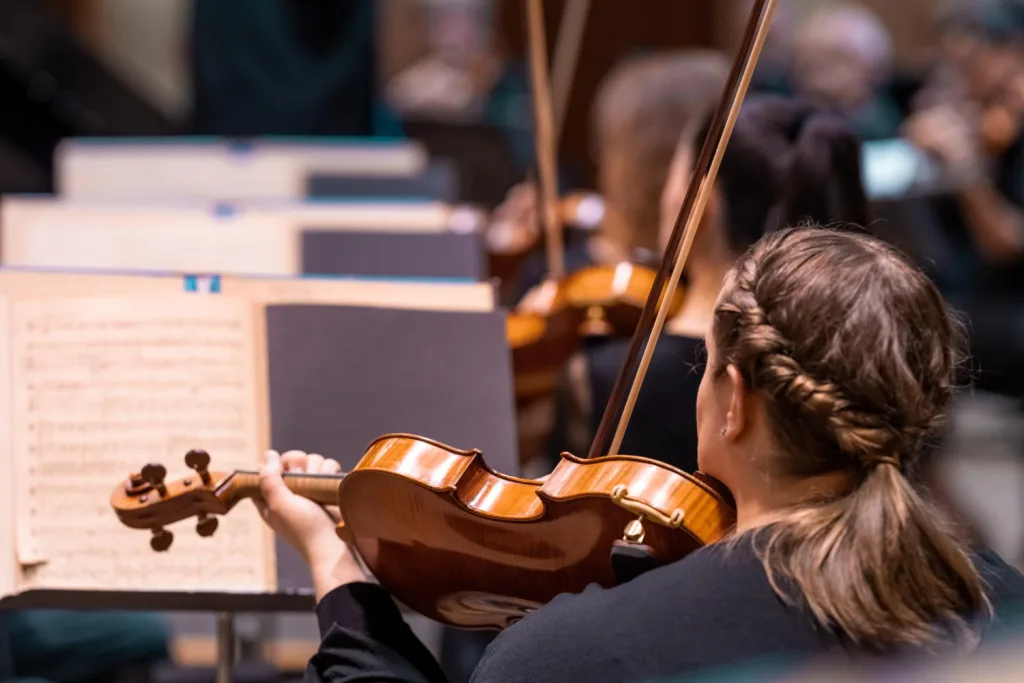In the world of classical music, string instruments hold a special place. They are the backbone of the orchestra, producing a harmonious symphony that has the power to stir the soul. The orchestra is like a well-orchestrated team, where each instrument plays a crucial role. Among these, the string section stands out for its depth and versatility. These instruments produce sound by vibrating strings, creating music that ranges from soothing melodies to grand crescendos. In this topic, we’ll answer your questions about an orchestra’s five main string instruments, their unique characteristics, and their vital contributions to the symphonic world.
What Are the 5 Main String Instruments in an Orchestra?
Before we dive into the specifics, let’s identify the five main string instruments that grace the orchestra with their presence:
- Violin
- Viola
- Cello
- Double Bass
- Harp
Now, let’s explore each of these instruments individually.
Violin
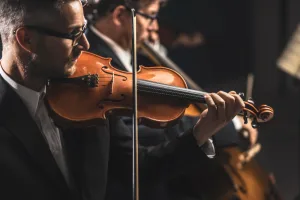
The Violin, often affectionately called the “queen of instruments,” holds a special place in the orchestra. It is the smallest and highest-pitched member of the string family, yet it can remarkably stir a wide range of emotions in the listener. The violin is frequently the lead instrument in the orchestra, captivating audiences with its virtuosity and eloquent melodies. Key Characteristics of the Violin:
Four Strings Tuned in Perfect Fifths: The violin has four strings—G, D, A, and E—each tuned a perfect fifth apart, allowing for a broad tonal range.
Played with a Bow Made of Horsehair: To produce its signature sound, the violinist uses a bow, traditionally crafted with horsehair, drawn across the strings, creating the resonant and sweet tones for which the instrument is renowned.
A Vital Role in Both Classical and Contemporary Music: The violin is versatile and fundamental in classical compositions and various contemporary genres. It’s a featured instrument in symphonies, concertos, chamber music, and even popular music, where its expressive qualities shine.
Viola
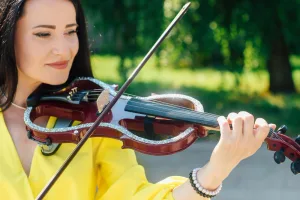
The Viola, slightly larger than its sibling, the violin, offers a warmer and deeper tonal quality. Within the orchestra, the viola plays a crucial role in harmonizing with the other string instruments, filling the mid-range frequencies, and adding depth to the overall orchestral sound. Key Characteristics of the Viola:
Four Strings tuned a Perfect Fifth Apart: Like the violin, the viola features four strings, each tuned a perfect fifth apart, typically C, G, D, and A, contributing to its distinctive sound.
Played with a Bow: The viola, too, is played with a bow, allowing the musician to coax out its rich, resonant tones.
Not as Well-Known as the Violin but Equally Essential: While the viola may not enjoy the same fame as its smaller cousin, it plays an equally essential role in creating the orchestra’s rich tapestry. It provides the crucial middle harmonies that bring cohesion to the ensemble’s overall sound.
Cello
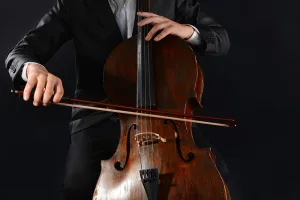
The Cello, often called the “soul” of the orchestra, carries a deep and resonant sound that brings a sense of gravity and grandeur to the ensemble. Its tonal quality is said to be the closest to the human voice, making it a favorite choice for emotional and expressive solos within the orchestra. Key Characteristics of the Cello:
Four Strings Tuned in Perfect Fifths: Like the violin, the cello boasts four strings tuned in perfect fifths. C, G, D, and A strings allow the cellist to explore a wide dynamic range.
Played While Seated and Supported Between the Knees: Cellists play this instrument while seated, with the cello’s body supported between their knees. This position enables them to draw rich and evocative tones from the strings.
Offers a Wide Dynamic Range and Soul-Stirring Melodies: The cello’s ability to convey profound emotions and produce a wide dynamic range makes it an indispensable component of the orchestra. It often takes center stage with solo performances that move the audience’s hearts.
Double Bass
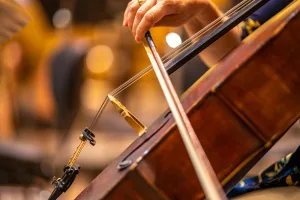
The Double Bass, often humorously referred to as the “doghouse” due to its size, is the giant of the string section. It produces the lowest frequencies in the orchestra, imparting a deep, rumbling sound that provides a solid foundation for the entire ensemble. Key Characteristics of the Double Bass:
- Four Strings, Tuned in Fourths: Unlike the other string instruments in the orchestra, the double bass features four strings tuned in fourths—E, A, D, and G.
- Played Standing Up or Seated on a Tall Stool: Double bassists may choose to play while standing or seated on a tall stool, depending on the musical piece and personal preference. The instrument’s size requires a unique playing stance.
- Essential for Maintaining the Rhythmic Pulse and Harmonic Support: The double bass is an indispensable component of the orchestra, maintaining the rhythmic pulse and providing essential harmonic support. Its deep, resonant tones give the orchestra a strong and stable foundation.
Harp
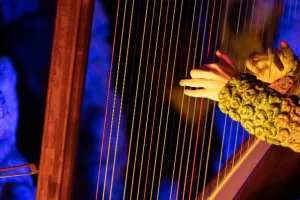
The Harp stands out as a unique member of the orchestra. Its design and playing technique differ significantly from the other string instruments, adding a touch of ethereal beauty to orchestral compositions with its shimmering glissandos and delicate plucking. Key Characteristics of the Harp:
Multiple Strings, Often Ranging from 40 to 47: The harp boasts a myriad of strings, varying in number depending on the harp’s size. This diversity allows harpists to create a wide range of tonal colors.
Played by Plucking the Strings with the Fingers: Harpists pluck the strings with their fingers, producing the instrument’s signature ethereal sound. This unique playing technique sets the harp apart from the other string instruments.
Primarily Used for Arpeggios, Glissandos, and Creating a Magical Atmosphere: While the harp can certainly contribute to melodic lines, it excels in creating enchanting arpeggios and glissandos, which add a magical atmosphere to orchestral compositions.
The Harmony of Strings in an Orchestra
Now that we’ve met the five main string instruments, let’s explore how they work together in perfect harmony within the orchestra.
- Melodic Bliss: Violins often lead the melody, supported by the other string instruments, creating a lush, harmonious sound.
- Chords and Depth: Violas and cellos contribute to the rich harmonies by playing chords and adding depth to the music.
- The Backbone: The double bass and its powerful, low-frequency tones are the backbone, providing the rhythmic and harmonic foundation for the entire orchestra.
- A Touch of Magic: The harp adds a touch of magic with its unique glissandos and arpeggios, creating an otherworldly atmosphere in the music.
The synergy among these instruments is what gives an orchestra its magical quality.
Conclusion
In music, the five main string instruments in an orchestra—violin, viola, cello, double bass, and harp—stand as the pillars of beauty and expression. Their unique sounds and roles within the ensemble create captivating symphonies that have enchanted audiences for centuries. Now, when you ask, “What are the five main string instruments in an orchestra?” You’ll have the answer and a deeper appreciation for the magic they bring to the music world.

